
Epicyon is a large, extinct, canid genus of the subfamily Borophaginae, native to North America. Epicyon existed for about 15 million years from the Hemingfordian age of the Early Miocene, to the Hemphillian of the Late Miocene. Epicyon haydeni is the largest known canid of all time, with the type species reaching 2.4 m (7.9 ft) in length, 90 cm (35 in) in shoulder height and approximately 100–125 kg (220–276 lb) in body mass. The largest known humerus specimen belonged to an individual weighing up to 170 kg (370 lb).

Ailuropodinae is a subfamily of Ursidae that contains only one extant species, the giant panda of China. The fossil record of this group has shown that various species of pandas were more widespread across the Holarctic, with species found in places such as Europe, much of Asia and even North America. The earliest pandas were not unlike other modern bear species in that they had an omnivorous diet but by around 2.4 million years ago, pandas have evolved to be more herbivorous.

Amphicyon is an extinct genus of large carnivorans belonging to the family Amphicyonidae, subfamily Amphicyoninae, from the Miocene epoch. Members of this family received their vernacular name for possessing bear-like and dog-like features. They ranged over North America, Europe, Asia, and Africa.

Agriotherium is an extinct genus of bears whose fossils are found in Miocene through Pleistocene-aged strata of North America, Eurasia, and Africa. This long-lived genus persisted from at least ~11.6–2.5 Mya. Materials from the late-surviving A. africanum in Africa have suggested that A. africanum died out during the early Gelasian.
Parictis is an extinct arctoid belonging to the family Subparictidae.
Miomachairodus is an extinct genus of large machairodontine containing only a single species, Miomachairodus pseudailuroides. It is known from Miocene-age fossils in China and Turkey and persisted until the Late Miocene. Fossils of this machairodont have been found in the Vallesian-age Bahe Formation in Shaanxi, China, and Yeni Eskihisar in Anatolia. This Turkish site is of Miocene age and is well known for its pollen studies.
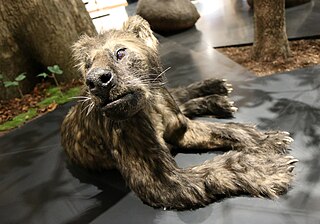
Agnotherium is a genus of large sized carnivoran mammals, belonging to the Amphicyonidae, which has been found in Western Europe, and possibly China and Northern Africa, and lived during the Late Miocene epoch. Despite only being known from fragmentary remains, the genus notable for hypercarnivorous adaptions, which have been said to represent the "apex" among its family.
Gobicyon is an extinct genus of large-sized carnivoran mammals, belonging to the Amphicyonidae, that was discovered in China, Mongolia, and Serbia, and lived during the Middle Miocene epoch. Despite only being known from rather fragmentary remains, recent discoveries showcase that it was an aberrant member of the subfamily Haplocyoninae, with adaptions towards bone-crushing similar to those of a hyaena.

Asiavorator is an extinct genus of civet-like carnivoran belonging in the family Stenoplesictidae. It was endemic to Asia and lived during the Eocene and Oligocene epochs.

Hemicyoninae is an extinct subfamily of Ursidae, often called dog bears. They were bear-like carnivorans living in Europe, North America, Africa and Asia during the Oligocene through Miocene epochs 33.9–5.3 Ma, existing for approximately 28.6 million years. They are sometimes classified as a separate family.
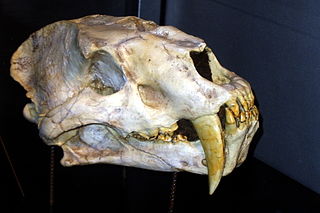
Amphimachairodus is an extinct genus of large machairodonts. It is also a member of the tribe Homotherini within Machairodontinae and is most closely related to such species as Xenosmilus, Homotherium itself, and Nimravides. It inhabited Eurasia, Northern Africa and North America during the late Miocene epoch.

Kretzoiarctos is an extinct bear genus from the European Miocene. It consists of Kretzoiarctos beatrix, an ancestor of the extant giant panda.

Agriotheriini is an extinct tribe of ailuropodine bears from the Middle Neogene to Early Quaternary periods with fossils found from Eurasia, Africa and North America. The tribe consists of the genera Agriotherium, Huracan, Indarctos, and possibly Miomaci. The taxonomy of these bears has variously placed some of the genera in other bear lineages such as Hemicyoninae and Ursavinae.

Magericyon is an extinct genus of Amphicyonid ("bear-dog") that lived during the Miocene 10-9 Ma in what is now Spain.
Ursus dolinensis is an extinct mammalian carnivore species of the Ursidae family. Its fossilized remains were unearthed from the lowest layers of the stratigraphic sequence at the archaeological and paleontological site of Gran Dolina, that is a part of the Atapuerca Mountains complex in the Burgos province, northern Spain. The species was described by Nuria Garcia and Juan Luis Arsuaga in a 2001 publication. Skeletal fossils, mainly cranial fragments were recovered from the sediment units TD 3 and in particular TD 4. Presence in these layers suggests a chronology in between 900,000 and 780,000 years ago, which falls into the Calabrian stage of the early Pleistocene.
Azygonyx was a small tillodont mammal, likely the size of a cat to raccoon, that lived in North America during the Paleocene and Eocene in the early part of the Cenozoic Era. The only fossils that have been recovered are from the Willwood and Fort Union Formations in the Bighorn Basin of Wyoming, United States, and date to the Clarkforkian to Wasatchian, about 56 to 50 million years ago. Fifty-six collections that have been recovered thus far include the remains of Azygonyx. Azygonyx survived the Paleocene Eocene Thermal Maximum along with other mammals like Phenacodus and Ectocion, both of which were ground-dwelling mammals. Azygonyx probably was a generalist terrestrial mammal that may have roamed around the ground, but was also capable of climbing trees.
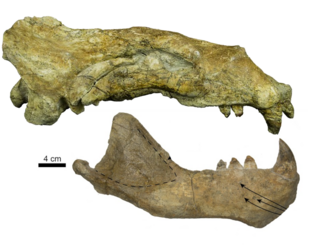
Titanotaria is a genus of late, basal walrus from the Miocene of Orange County, California. Unlike much later odobenids, it lacked tusks. Titanotaria is known from an almost complete specimen which serves as the holotype for the only recognized species, Titanotaria orangensis, it is the best preserved fossil walrus currently known.
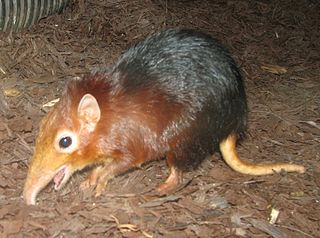
Eorhynchocyon is an extinct mammal genus from the macroscelidid superfamily.
Delotrochanter is an extinct genus of large-sized carnivoran mammals, belonging to the Amphicyonidae, that lived in the Great Plains of North America during the Oligocene to Early Miocene. This genus includes some of the largest and last surviving members of the subfamily Temnocyoninae. it furthermore possesses adaptions towards both bone-crushing and cursoriality.
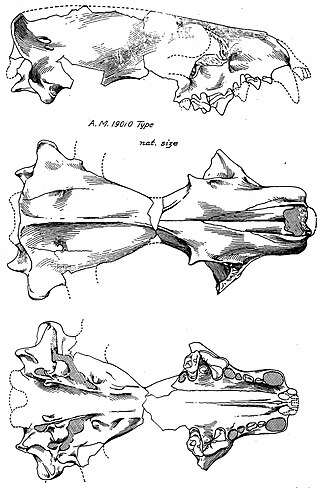
Amphicticeps is an extinct genus of small, weasel-like carnivoran mammal. It lived in Mongolia during the Oligocene. The genus was erected in 1924 for the species A. shackelfordi on the basis of a well-preserved skull. Historically, the systematic position of this genus has been problematic until more specimens were described decades later.













